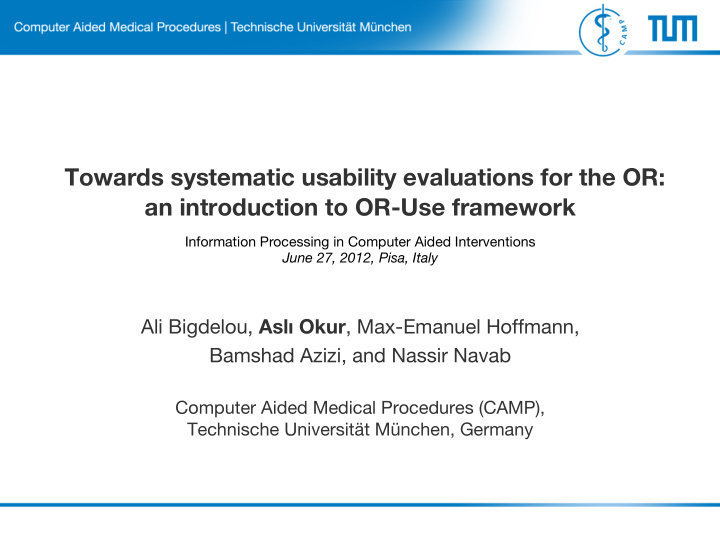



Towards systematic usability evaluations for the OR: an introduction to OR-Use framework Information Processing in Computer Aided Interventions June 27, 2012, Pisa, Italy Ali Bigdelou, Aslı Okur , Max-Emanuel Hoffmann, Bamshad Azizi, and Nassir Navab Computer Aided Medical Procedures (CAMP), Technische Universität München, Germany
OR in a Nutshell: � � • Collaborative Environment � • Surgical Workflow � • Distributed Platform � 2 � Bigdelou et al., 2011: OR Specific Domain Model for Usability Evaluations of Intra-Operative Systems. �
Motivation • Complicated technological equipment in the OR – Increased complexity • Deficiencies in the design of medical technology – Risk of human error • Preventable medical errors – 44,000 to 98,000 people die each year just in the U.S. – 60% of adverse events are caused by use errors – Wrong usage of technical equipment is the main reason for adverse events in medicine • Usability engineering is aiming at improving the human computer interaction – the complexity of the medical domain aggravates the work of usability specialists [Wachter, 2004: The end of the beginning: Patient safety five years after ’to err is human’.] [Bleyer, 1992: Medizinisch-technische Zwischenfälle in Krankenhäusern und ihre Verhinderung]
Usability Testing in General • Technique used to evaluate a product by testing it on users – Direct input on how real users use the system • Usability can be measured with Nielsen components defined as – Learnability – Efficiency – Memorability – Errors – Satisfaction • Main steps of usability engineering: – Planning – Conduction – Analysis and Report • In complex domains it is very challenging and requires high level of domain knowledge and expertise. [Jakob Nielsen, 1994: Usability Engineering]
Objectives • Performing a complete usability test is not always an easy endeavor and requires high level of domain knowledge and expertise: – Acquisition of usability data – Management of usability data – Analysis of huge amount of collected information • Several usability testing support tools have been proposed in different domains. Our Goal � • To exploit the Domain Knowledge into the usability study for the OR. • Define a new tool to support usability testing in the OR. • Propose a novel and flexible analysis method. http://www.infodesign.com.au/usabilityresources/usabilitytesting � [Chilana et al. 2010: Understanding usability practices in complex domains] [Ivory, 2001: The state of the art in automating usability evaluation of user interfaces]
OR Specific Domain Model 1. Decompose the domain Workflow Stages into its sources of complexity modeled as distinct views 2. Select a proper modeling Surgical ¡ Workflow ¡ technique to represent each view Mapping ¡ Mapping ¡ and driving its elements Table ¡ Table ¡ 3. Establish a clear connection between the defined views by mapping their elements Target Human Device Roles Mapping ¡ Table ¡ OR Domain Model (State – Feature) Pairs Actor Roles Bigdelou et al., IPCAI 2011: OR Specific Domain Model for Usability Evaluations of Intra-operative Systems 6
Architecture of OR-Use Framework � • In order to support the conduction of usability tests a specialized architecture is proposed and developed at CAMP. � • Here we briefly go through main components of the proposed framework. �
Architecture - Planning � • During the planning stage a specific model of the target Surgical ¡ Workflow ¡ surgery can be defined. � Mappin Mappin g ¡Table ¡ g ¡Table ¡ • This model consists of instances of each view and their OR Domain correlations stored in Mapping Tables. � Model � Target Human Device � Roles � • The model is stored in a XML format. � • Several part of the framework use this model to tailor their Mappin functionalities based on the target scenario. � g ¡Table ¡
Architecture - Conducting � • The original performance log of the device is converted to the format known to the OR-Use framework. � • For each new device a convertor is needed for the conversion. � • This design decision makes the framework independent from particular platform that has been used for the intra-operative device. �
Architecture - Conducting � • A handheld annotation tool is designed to facilitate the annotation of usability testing phase. � • This is developed for Android smart phones. � • The domain model XML is used to populate the UI. � • The proposed GUI is designed based on tasks of the usability engineer within the test. �
Architecture - Conducting � • The collected usability data are combined in a XML message. � • The generated XML is then encrypted and transmitted to the server. �
Architecture - Centralized Data Management � • A dedicated web service enables the simultaneous access to the server. � • After receiving the encrypted XML message, the usability data are decrypted and extracted using a proper extractor. � • This design enables definition of new data types specific for a given device. �
Architecture - Centralized Data Management � • The extracted data are then stored in Data pool and Database. � • Files are stored in a secured public repository on the server side called data pool. � • A relational database has been used in order to map the usability data to the OR specific domain model. �
Architecture - Analysis � • A dedicated web service is used to retrieve the usability data, which enables multiple view of the data (as needed for cross configuration analysis). � • The data can be filtered specifying a proper query including search criteria. � HostAddress? collection="UserInteraction"&Configuration="2.3"&WorkflowStage="Sca nning"&HumanRole="Surgeon"&DeviceFeature="Brightness"
Architecture - Analysis � • A higher level view of data has achieved facilitating MS Pivot visualization toolkit. � • A dedicated web service generates Pivot collections (CXML files) based on the results retrieved from the data retrieval service. � • The same query format has been proposed and used for generating the results. �
Architecture - Analysis � • Any web browser, equipped with Silverlight and with internet access can be used to view the Pivot visualization. �
THANK YOU FOR YOUR ATTENTION
Recommend
More recommend